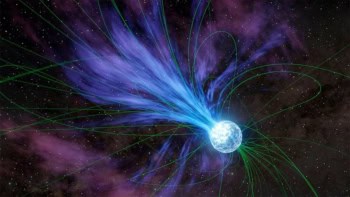
Physicists in the US have detected the nuclear decay of individual helium nuclei by embedding radioactive atoms in a micron-sized object and measuring the object’s recoil as a particle escapes from it. The technique, which is an entirely new way of studying particles emitted via nuclear decay, relies on the principle of momentum conservation. It might also be used to detect other neutral decay products, such as neutrinos and particles that could be related to dark matter and might escape detection by other means.
The conservation of momentum is a fundamental concept in physics, together with the conservation of energy and the conservation of mass. The principle is that as momentum (mass multiplied by velocity) can be neither created nor destroyed, the total amount of it must remain constant – as described by Newton’s laws of motion.
Outgoing decay product will exert a backreaction
Physicists led by David Moore of Yale University have now used this principle to determine when a radioactive atom emits a single helium nucleus (or alpha particle) as it decays. The idea is as follows: if the radioactive atom is embedded in a larger object, the outgoing decay product will exert a back-reaction on the object, making it recoil in the opposite direction. “This is similar to throwing a ball while on a skateboard,” explains team member Jiaxiang Wang. “After the ball has been thrown, the skateboard will slowly roll backward.”
The backreaction on a large object from just a single nucleus inside it would normally be too tiny to detect, but the Yale researchers managed to do it by precisely measuring the object’s motion using the light scattered from it. Such a technique can gauge forces as small as 10-20 N and accelerations as tiny as 10-7 g, where g is the local acceleration due to the Earth’s gravitational pull.
“Our technique allows us to determine when a radioactive decay has occurred and how large the momentum the decaying particle exerted on the object,” Wang says. “Momentum conservation ensures that the momentum carried by the object and the emitted alpha particle are the same. This means that measuring the object’s recoil provides us with information on the decay products.”
Optical tweezer technique
In their experiment, Moore, Wang and colleagues embedded several tens of radioactive lead-212 atoms in microspheres made of silica. They then levitated one microsphere at a time using the forces generated by a focused laser beam. This technique is known as an optical tweezer and is routinely employed to hold and move nano-sized objects. The researchers recorded recoil measurements over a period of two to three days as the lead-212 (which has a half-life of 10.6 hours) decayed to the stable isotope lead-208 through the emissions of alpha and beta particles (electrons).
According to Wang, the study is an important proof of principle, demonstrating conclusively that a single nuclear decay can be detected when it occurs in a much larger object. But the team also hopes to put it to good use for other applications. “We undertook this work as a first step towards directly measuring neutrinos as decay products,” Wang explains. “Neutrinos are central to many open questions in fundamental physics but are extremely difficult to detect. The technique we have developed could be a completely new way to study them.”

Exotic nuclear decay observed in dark-matter detector
As well as detecting neutrinos, the new method, which is detailed in Physical Review Letters, could also be of interest for nuclear forensics. For example, it could be used to test whether dust particles captured from the environment contain potentially harmful radioactive isotopes.
The Yale researchers now plan to extend their technique to smaller silica spheres, which have better momentum sensitivity. “These smaller objects will allow us to sense the momentum kick from a single neutrino,” Wang tells Physics World. “Eventually, an approach like ours might also be applied to large arrays of spheres to sense other types of previously undetected, rare decays.”



